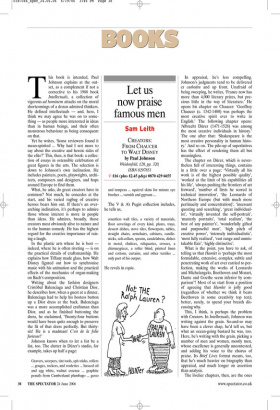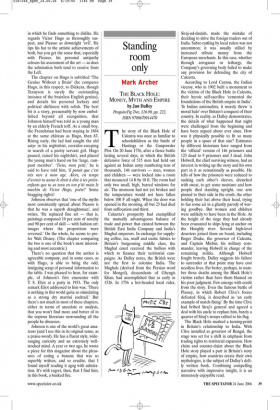Let us now praise famous men
Sam Leith
CREATORS: FROM CHAUCER TO WALT DISNEY by Paul Johnson Weidenfeld, £20, pp. 320, ISBN 0297851 ✆ £16 (plus £2.45 p&p) 0870 429 6655 This book is intended, Paul Johnson explains at the outset, as a complement if not a corrective to his 1988 book Intellectuals, a collection of vigorous ad hominem attacks on the moral shortcomings of a dozen admired thinkers. He defined intellectuals — and, here, I think we may agree he was on to something — as people more interested in ideas than in human beings, and their often monstrous behaviour as being consequent on that.
Yet he writes, ‘Some reviewers found it mean-spirited ... Why had I not more to say about the creative and heroic sides of the elite?’ This, then, is that book: a collection of essays in ostensible celebration of great figures in the arts. The selection is down to Johnson’s own inclination. He includes painters, poets, playwrights, architects, composers and designers, and hops around Europe to find them.
What, he asks, do great creators have in common? Not much, he concedes at the start, and his varied ragbag of creative heroes bears him out. If there’s an overarching inclination, it’s perhaps to admire those whose interest is more in people than ideas. He admires, broadly, those creators most obviously alive to nature and to the human comedy. He has the highest regard for the creative importance of raising a laugh.
In the plastic arts where he is best indeed, where he is often riveting — is on the practical details of craftsmanship. He explains how Tiffany made glass, how Walt Disney figured out how to synchronise music with his animation and the practical effects of the mechanics of organ-making on Bach’s composition.
Writing about the fashion designers Cristóbal Balenciaga and Christian Dior, he describes how, when a guest at a dinner, Balenciaga had to help his hostess button up a Dior dress at the back. Balenciaga was a more accomplished craftsman than Dior, and as he finished buttoning the dress, he exclaimed, ‘Twenty-four buttons would have been quite enough to preserve the fit of that dress perfectly. But thirtysix! He is a madman! C’est de la folie furieuse!’ Johnson knows when to let a list be a list, too. The clutter in Dürer’s studio, for example, takes up half a page:
and tempera ... squirrel skins for minute eye brushes ... varnish and gypsum ...
The V & A’s Pugin collection includes, he tells us,
countless wall tiles, a variety of materials, floor coverings of every kind, plates, trays, dessert dishes, stove tiles, flowerpots, tables, straight chairs, armchairs, cabinets, candlesticks, salt-cellars, spoons, candelabras, dishes in metal, chalices, reliquaries, crosses, a chimneypiece, a roller blind, printed linen and cottons, curtains, and other textiles ... only part of his output.
In appraisal, he’s less compelling. Johnson’s judgments tend to be delivered ex cathedra and up front. Unafraid of being sweeping, he writes, ‘France now has more than 4,000 literary prizes, but precious little in the way of literature.’ He opens his chapter on Chaucer: ‘Geoffrey Chaucer (c. 1342-1400) was perhaps the most creative spirit ever to write in English.’ The following chapter opens: ‘Albrecht Dürer (1471-1528) was among the most creative individuals in history.’ The one after that: ‘Shakespeare is the most creative personality in human history.’ And so on. The pile-up of superlatives has the effect of rendering them all but meaningless.
The chapter on Dürer, which is nevertheless full of interesting things, contains in a little over a page: ‘Virtually all his work is of the highest possible quality’, ‘worked at the limit of his capabilities all his life’, ‘always pushing the frontiers of art forward’, ‘number of firsts he scored in technical innovation’, ‘the Leonardo of Northern Europe (but with much more pertinacity and concentration)’, ‘incessant questing and searching’, ‘great individualist’, ‘virtually invented the self-portrait’, ‘masterly portraits’, ‘total realism’, ‘the best of any painter’s’, ‘wonderfully gifted and purposeful men’, ‘high pitch of creative power’, ‘intensely individualistic’, ‘most fully realised’, ‘vast range and unmistakable flair’, ‘highly distinctive’.
What is the point, you have to ask, of telling us that Hamlet is ‘perhaps the most formidable, extensive, complex, subtle and penetrating work of art ever carried to perfection, making the works of Leonardo and Michelangelo, Beethoven and Mozart, Dante and Goethe seem inferior by comparison’? Most of us start from a position of agreeing that Hamlet is jolly good (regardless of whether we think it beats Beethoven in some creativity top ten); better, surely, to spend your breath discussing why.
This, I think, is perhaps the problem with Creators. In Intellectuals, Johnson was writing against the grain. So-and-so may have been a clever chap, he’d tell us, but what an ocean-going bastard he was, too. Here, he’s writing with the grain, picking a number of men and women, mostly men, whose excellence is generally uncontested, and adding his voice to the chorus of praise. Its Brief Lives format means, too, that he’s much heavier on biography than appraisal, and much longer on assertion than analysis.
The livelier chapters, then, are the ones in which he finds something to dislike. He regards Victor Hugo as thoroughly suspect, and Picasso as downright ‘evil’. He tips his hat to the artistic achievements of both, but you get the sense that, especially with Picasso, his personal antipathy colours his assessment of the art — as does the admiration both tend to receive from the Left.
The chapter on Hugo is subtitled ‘The Genius Without a Brain’ (he compares Hugo, in this respect, to Dickens, though Tennyson is surely the outstanding instance of the brainless English genius), and details his personal lechery and political shiftiness with relish. The best bit is a story, presumably by now embellished beyond all recognition, that Johnson himself was told as a young man by an elderly French toff. As a small boy, the Frenchman had been staying in 1884 at the same château as Hugo, then 83. Rising early, the lad had caught the old satyr in his nightshirt, corridor-creeping in search of a pretty servant girl. Hugo paused, raised his nightshirt, and placed the young man’s hand on his ‘large, rampant member’. ‘Tiens, mon petit,’ he is said to have told him, ‘il parait que c’est très rare à mon age. Alors, en temps d’avenir tu auras le droit à dire à tes petitsenfants que tu as tenu en ton p’tit main le machin de Victor Hugo, poète!’ Some bragging rights!
Johnson observes that ‘one of the myths most consistently spread about Picasso is that he was a superb draughtsman’, and writes, ‘He replaced fine art — that is, paintings composed 10 per cent of novelty and 90 per cent of skill — with fashion art: images where the proportions were reversed.’ On the whole, he seems to prefer Walt Disney. (The chapter comparing the two is one of the book’s most interesting and most eccentric.) There’s no question that the author is agreeable company, and in some cases, as with Hugo, is able to bring the odd, intriguing scrap of personal information to the table. I was pleased to hear, for example, of Johnson’s first encounter with T. S. Eliot at a party in 1953. The only remark Eliot addressed to him was, ‘There is nothing in this world quite so stimulating as a strong dry martini cocktail.’ But there’s not much in most of these chapters, either in terms of anecdote or analysis, that you won’t find more and better of in the copious literature surrounding all the people he discusses.
Johnson is one of the world’s great amateurs (and I use this in its original sense, as a praise-word). He has a fluent style, wideranging curiosity and an extremely wellstocked mind. A year or two ago, he wrote a piece for this magazine about the pleasures of eating a banana that was so superbly written, and so erudite, that I found myself reading it agog with admiration. It’s with regret, then, that I find him, in this book, a banked fire.




















































 Previous page
Previous page